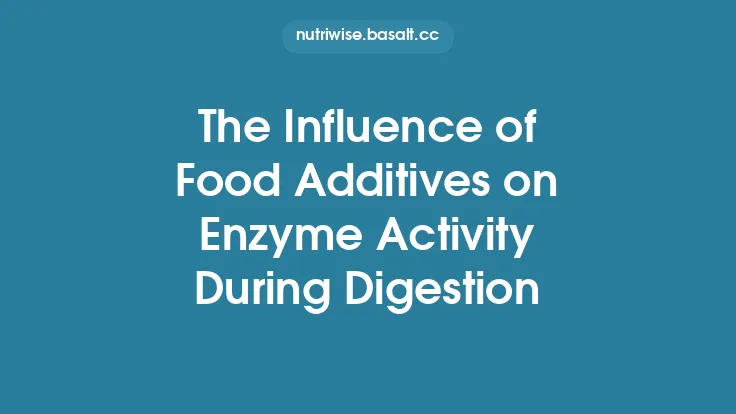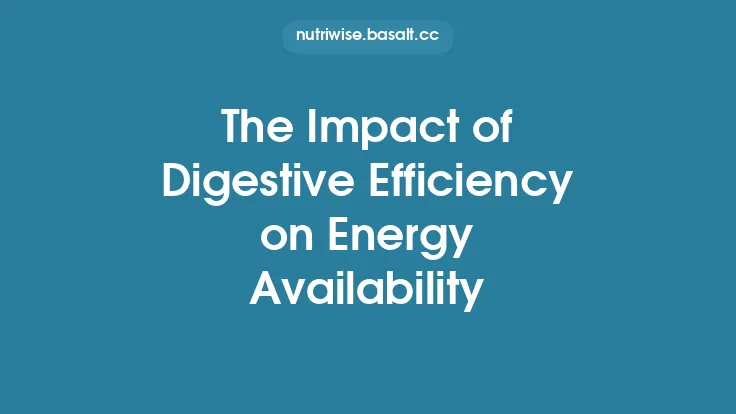The digestive system is a finely tuned biochemical assembly line, and one of the most critical parameters that governs its efficiency is the acidity or alkalinity of the environment in which reactions occur. Throughout the gastrointestinal (GI) tract, pH does not remain constant; instead, it varies dramatically from the highly acidic stomach to the near‑neutral small intestine and the slightly alkaline colon. These pH gradients are not incidental—they are essential for shaping the three‑dimensional structure of digestive enzymes, dictating substrate accessibility, and ultimately determining how effectively nutrients are broken down and absorbed. Understanding how pH influences enzyme activity provides a foundation for appreciating normal digestion, recognizing the origins of many gastrointestinal disorders, and guiding interventions that aim to restore optimal digestive function.
The pH Landscape of the Human Digestive Tract
| Region | Typical pH Range | Primary Physiological Role |
|---|---|---|
| Oral cavity | 6.2 – 7.4 | Initial mechanical processing; saliva provides mild buffering |
| Esophagus | 6.5 – 7.5 (resting) | Transport of bolus; brief exposure to gastric acid during reflux |
| Stomach (luminal) | 1.5 – 3.5 (fasted) → 4 – 5 (post‑prandial) | Protein denaturation, activation of gastric enzymes |
| Duodenum (proximal) | 5.5 – 6.5 | Neutralization of gastric acid, initiation of pancreatic secretions |
| Jejunum & Ileum | 6.0 – 7.5 | Major site of nutrient absorption |
| Colon (proximal) | 5.5 – 6.5 | Fermentation of undigested residues, water reabsorption |
| Colon (distal) | 6.5 – 7.5 | Fecal formation, microbial activity |
These values are averages; individual variation exists due to factors such as age, diet, medication, and underlying health conditions. The steep pH gradient from the stomach to the small intestine is especially important because it creates distinct microenvironments where specific sets of enzymes can operate at peak efficiency.
Molecular Basis of pH‑Dependent Enzyme Function
Enzymes are proteins whose catalytic power derives from the precise arrangement of amino‑acid side chains within the active site. The ionization state of these side chains is directly influenced by the surrounding hydrogen‑ion concentration (pH). Two principal mechanisms explain how pH modulates activity:
- Protonation/De‑protonation of Catalytic Residues
Many enzymes rely on acidic (e.g., Asp, Glu) or basic (e.g., Lys, Arg, His) residues to donate or accept protons during the reaction cycle. If the ambient pH shifts the equilibrium away from the required ionization state, the catalytic step becomes energetically unfavorable, reducing turnover.
- Conformational Stability and Tertiary Structure
The overall three‑dimensional fold of a protein is stabilized by a network of ionic bonds, hydrogen bonds, and salt bridges. Extreme pH values can disrupt these interactions, leading to partial unfolding (denaturation) or subtle conformational changes that misalign the active site. Even minor structural perturbations can dramatically lower catalytic efficiency.
The relationship between enzyme activity (v) and pH often follows a bell‑shaped curve, with a clear optimum (pH_opt) where the enzyme exhibits maximal velocity (V_max). The curve’s symmetry reflects the balance between the ionization of groups that must be protonated and those that must be de‑protonated for catalysis. Mathematically, this can be expressed using the Henderson–Hasselbalch equation applied to the relevant ionizable groups, allowing prediction of activity across a pH spectrum.
Optimal pH Ranges for Major Digestive Compartments
While the previous table lists general pH values, it is useful to pair each region with the functional pH window that supports the collective enzymatic milieu present there.
- Stomach: The acidic environment (pH ≈ 2) is optimal for the bulk of gastric enzymes, which have evolved to function where most other proteins would be inactive. This acidity also serves a protective role, limiting microbial colonization and facilitating the unfolding of dietary proteins, making them more accessible to enzymatic attack.
- Duodenum: As chyme enters the duodenum, bicarbonate‑rich secretions from the pancreas and Brunner’s glands raise the pH to a mildly acidic to neutral range (pH ≈ 6). This shift is essential for the activation of pancreatic enzymes that are most active near neutral pH, while simultaneously preventing the premature inactivation of any residual gastric enzymes that may have survived the transition.
- Jejunum & Ileum: The pH gradually rises to a near‑neutral environment (pH ≈ 7). This range supports the final stages of carbohydrate and protein digestion, as well as the activity of brush‑border enzymes anchored to the epithelial surface. The neutral pH also preserves the integrity of the mucosal barrier.
- Colon: A slightly alkaline pH (pH ≈ 6.5–7.5) favors the growth of beneficial microbiota that ferment residual fibers and produce short‑chain fatty acids, which are important for colonic health. Although the colon is not a primary site of enzymatic digestion, the pH still influences the activity of microbial enzymes that contribute to nutrient salvage.
Physiological Mechanisms Maintaining pH Homeostasis
The body employs several coordinated systems to ensure that each digestive segment maintains its characteristic pH:
- Gastric Acid Secretion and Regulation
Parietal cells release hydrochloric acid (HCl) under the influence of gastrin, acetylcholine, and histamine. Negative feedback from low pH and somatostatin curtails further secretion, preventing excessive acidity.
- Bicarbonate Buffering in the Duodenum
Pancreatic ductal cells secrete a bicarbonate‑rich fluid that neutralizes incoming gastric acid. The secretion is stimulated by secretin, a hormone released when duodenal mucosa detects low pH.
- Mucosal Buffers and Secretions
The epithelial lining of the small intestine produces mucus containing bicarbonate ions, providing a localized buffer that protects the epithelium while fine‑tuning luminal pH.
- Enteric Nervous System (ENS) Coordination
The ENS monitors luminal conditions and modulates secretory activity via reflex arcs, ensuring rapid adjustments to pH fluctuations caused by meal composition or volume.
- Renal Compensation (Systemic Influence)
Although primarily a systemic regulator, the kidneys contribute to overall acid‑base balance, indirectly influencing the baseline pH of bodily fluids that feed into the digestive tract.
These mechanisms operate continuously, allowing the GI tract to adapt to the dynamic pH challenges presented by different meals and physiological states.
Consequences of pH Imbalance on Digestive Efficiency
When the finely tuned pH environment is disturbed, several functional impairments can arise:
- Reduced Enzyme Catalysis
Even a shift of 0.5–1 pH unit away from the optimum can cut enzyme activity by 30–50%, slowing the breakdown of macronutrients and leading to incomplete digestion.
- Altered Substrate Solubility
pH influences the ionization state of nutrients themselves. For instance, certain minerals become less soluble in highly alkaline conditions, limiting their availability for absorption.
- Mucosal Damage
Excessive acidity in the duodenum can erode the protective mucus layer, predisposing the mucosa to inflammation and ulceration. Conversely, insufficient acidity in the stomach can impair the barrier against ingested pathogens.
- Microbial Dysbiosis
The colon’s pH is a key determinant of microbial composition. A shift toward a more acidic environment can suppress beneficial fermenters while encouraging acid‑tolerant opportunists, potentially contributing to bloating, gas, and altered bowel habits.
- Feedback Disruption
Hormonal signals such as gastrin and secretin rely on accurate pH sensing. Misreading the luminal pH can lead to inappropriate hormone release, further compounding the imbalance.
Collectively, these effects underscore why maintaining appropriate pH levels is not merely a biochemical curiosity but a cornerstone of digestive health.
Clinical Conditions Linked to Aberrant pH
| Condition | Primary pH Disturbance | Pathophysiological Impact |
|---|---|---|
| Gastric hypochlorhydria (low stomach acid) | pH > 4 in fasting state | Impaired protein denaturation, reduced activation of gastric enzymes, increased risk of bacterial overgrowth |
| Hyperacidity / Peptic ulcer disease | pH < 2 (excessive acid) | Mucosal erosion, pain, potential bleeding |
| Duodenal ulcer | Localized low pH despite bicarbonate buffering | Damage to duodenal mucosa, pain, malabsorption |
| Celiac disease | Altered duodenal pH due to villous atrophy | Impaired neutralization, maldigestion of nutrients |
| Irritable bowel syndrome (IBS) – diarrhea‑predominant | Slightly acidic colonic pH | Accelerated transit, altered microbial fermentation |
| Chronic constipation | Slightly alkaline colonic pH | Slowed motility, changes in microbial metabolism |
Diagnostic evaluation often includes pH monitoring (e.g., 24‑hour esophageal pH probe, gastric pH testing) and assessment of related biomarkers. Therapeutic strategies aim to restore the appropriate pH range, either by suppressing excess acid (proton‑pump inhibitors, H2 blockers) or by augmenting acid production (betaine HCl supplementation) where clinically indicated.
Dietary and Lifestyle Factors Influencing Gastrointestinal pH
- Meal Composition
- Protein‑rich meals stimulate gastric acid secretion, temporarily lowering stomach pH.
- High‑fat meals delay gastric emptying, prolonging exposure of the stomach lining to acid.
- Alkaline foods (e.g., fruits, vegetables) can modestly raise duodenal pH after neutralization of gastric acid.
- Meal Timing and Frequency
Intermittent fasting or prolonged gaps between meals can lead to basal gastric pH drifting upward, potentially affecting enzyme activation on the next meal.
- Beverage Choice
- Carbonated drinks introduce carbonic acid, transiently lowering gastric pH.
- Caffeinated beverages may increase acid secretion via gastrin release.
- Alcohol can irritate the gastric mucosa, altering acid production.
- Smoking
Nicotine stimulates gastrin release, increasing gastric acidity, while also impairing bicarbonate secretion in the duodenum.
- Stress
Acute stress activates the sympathetic nervous system, which can suppress gastric acid output, whereas chronic stress may increase acid secretion through cortisol‑mediated pathways.
- Medications
- Antacids provide immediate neutralization but can interfere with the normal pH gradient if overused.
- Proton‑pump inhibitors (PPIs) reduce gastric acid production for extended periods, potentially leading to hypochlorhydria.
- Bicarbonate‑containing antacids raise duodenal pH, which may affect the activity of pancreatic enzymes.
Understanding these influences enables individuals and clinicians to tailor dietary patterns and lifestyle habits that support optimal pH conditions for digestion.
Research Tools and Methods for Studying pH Effects
- In vitro Enzyme Kinetics at Controlled pH
Buffer systems (e.g., phosphate, citrate) allow precise pH adjustments to generate activity‑pH profiles for isolated digestive enzymes.
- pH‑Sensitive Microelectrodes
Miniaturized glass or solid‑state electrodes can be positioned within animal or human GI tracts to record real‑time luminal pH during various physiological states.
- Magnetic Resonance Spectroscopy (MRS)
Non‑invasive imaging techniques can infer pH by measuring chemical shift changes of endogenous metabolites.
- Computational Modeling
Molecular dynamics simulations predict how protonation states of active‑site residues shift with pH, offering insight into structural stability.
- Ex Vivo Tissue Perfusion Systems
Isolated intestinal segments are perfused with buffered solutions of varying pH to assess functional outcomes such as nutrient transport and enzyme activity.
These methodologies collectively deepen our understanding of how pH modulates digestive processes and guide the development of therapeutic interventions.
Future Directions and Emerging Insights
Research is increasingly focusing on the interplay between pH and the gut microbiome, recognizing that microbial metabolism both influences and is influenced by luminal acidity. Novel probiotic formulations aim to modulate colonic pH to favor beneficial fermenters, potentially improving nutrient salvage and gut health.
Another promising avenue is the design of pH‑responsive drug delivery systems that release therapeutic agents only when they encounter the specific pH of a target GI segment. Such precision could enhance the efficacy of enzyme replacement therapies while minimizing systemic side effects.
Finally, advances in personalized nutrition are leveraging continuous pH monitoring (e.g., ingestible capsules) to tailor dietary recommendations that maintain each individual’s optimal digestive pH profile, moving beyond one‑size‑fits‑all guidelines.
In sum, pH is a master regulator of digestive enzyme activity, orchestrating a cascade of biochemical events that transform the food we eat into absorbable nutrients. By appreciating the nuanced pH landscape of the gastrointestinal tract, recognizing the molecular mechanisms that link acidity to enzyme function, and acknowledging the clinical and lifestyle factors that can disturb this balance, we gain a comprehensive perspective on a cornerstone of human nutrition and health.





